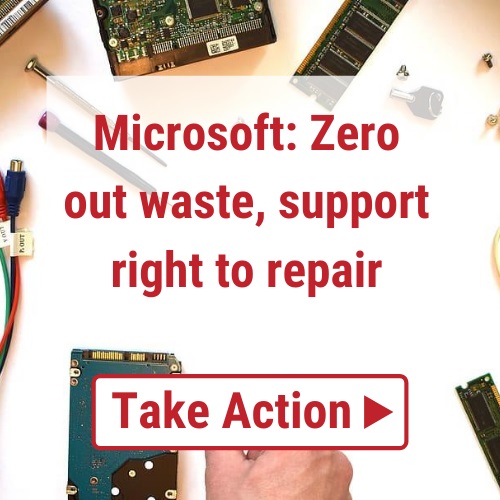
 |
Friend,
Microsoft has a new goal: generating zero waste from its direct operations by 2030.1
But how can Microsoft truly go zero waste while opposing our right to repair?2
U.S. PIRG is calling on Microsoft CEO Satya Nadella to help consumers slash their e-waste by making it easier to repair the things they already own. Will you join us?
In August, Microsoft announced its new goal to slash waste production in its operations to zero by 2030. This laudable commitment is a step in the right direction, and other companies should follow Microsoft's lead in reducing their waste.
But there's a big piece missing from Microsoft's waste reduction plan: right to repair. Microsoft doesn't plan to make itself responsible for e-waste generated on the consumer end: the laptops, desktop computers and other devices that are thrown away and replaced each year.3
The best way to reduce e-waste is to make it easier for consumers to fix and maintain our electronics instead of replacing them with newly manufactured models. A report by U.S. PIRG Education Fund estimates that if Americans were able to hold onto their phones for just one year longer on average, it would reduce manufacturing material consumption by 42.5 million pounds a day: the same as cutting a jumbo jet's weight in raw material use every 17 minutes. The reductions in global warming pollution would be equivalent to taking 636,000 cars off the road.4
Too often, though, consumers and third-party repair shops are unable to access the information and components needed to fix these devices due to unnecessary manufacturer restrictions.
Right to repair laws would help solve this problem. But Microsoft opposes legislation that would guarantee consumers and third-party repair specialists access to service information, parts, tools and diagnostic software.5 Just last year, the company helped block a promising right to repair bill in Washington state, according to insiders.6
If Microsoft reversed its opposition to right to repair and instead supported expanded repair options for consumers, it would make the company a true leader in slashing waste and making the electronics industry more sustainable.
That's why we're calling on Microsoft CEO Satya Nadella to support, not smother, our right to repair.
Thank you,
Faye Park
President
In the midst of the coronavirus outbreak, we've taken steps for all of our staff to work remotely for safety reasons. But rest assured, we'll keep advocating for you as we work for a healthier, safer world. Check out more of our resources for addressing the coronavirus. |
1. Justine Calma, "Microsoft aims for operations to be zero waste by 2030," The Verge, August 4, 2020.
2. Justine Calma, "Microsoft aims for operations to be zero waste by 2030," The Verge, August 4, 2020.
3. Justine Calma, "Microsoft aims for operations to be zero waste by 2030," The Verge, August 4, 2020.
4. "The Fix Is In," U.S. PIRG Education Fund, March 12, 2020.
5. Justine Calma, "Microsoft aims for operations to be zero waste by 2030," The Verge, August 4, 2020.
6. Nathan Proctor, "Microsoft played key role in stopping "Right to Repair" in Washington," Medium, April 12, 2019.
Support U.S. PIRG. Contributions by people just like you make our advocacy possible. Your contribution supports a staff of organizers, attorneys, scientists and other professionals who monitor government and corporate decisions and advocate on the public's behalf. |